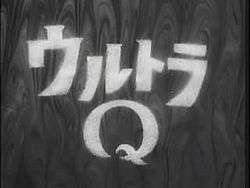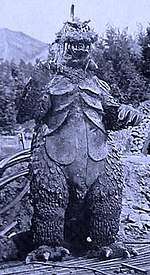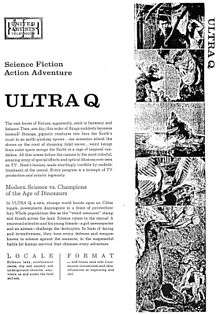Ultra Q
Ultra Q (ウルトラQ, Urutora Kyū) is a tokusatsu science fiction/kaiju series made in the tradition of Toho's many tokusatsu sci-fi/horror films.
| Ultra Q | |
|---|---|
 Original Japanese title card | |
| Genre | Tokusatsu Sci-Fi Fantasy Kaiju |
| Created by | Tsuburaya Productions |
| Developed by | Toshihiro Iijima |
| Directed by | Hajime Tsuburaya |
| Starring | Kenji Sahara, Yasuhiko Saijou, Hiroko Sakurai |
| Country of origin | Japan |
| No. of episodes | 28 |
| Production | |
| Running time | 24 minutes (per episode) |
| Production company(s) | Tsuburaya Productions |
| Distributor | |
| Release | |
| Original network | TBS Television |
| Original release | January 2 – July 3, 1966 |
| Chronology | |
| Followed by | Ultraman |
Produced in black and white by Tsuburaya Productions, this is actually the first of the long-running Ultra Series, and was broadcast on Tokyo Broadcasting System (TBS) from January 2 to July 3, 1966 (the final episode was preempted until December 14, 1967), with a total of 28 episodes. This series was followed two weeks later by the more popular Ultraman (1966), the second Ultra Series.
Ultra Q can be described as a half-hour Toho kaiju series. Executive Producer Eiji Tsuburaya intended this series to be more like the American television series The Twilight Zone and The Outer Limits, featuring all kinds of strange and unusual stories. After a survey, the TBS network convinced Tsuburaya Productions to add more giant monsters, as children were intensely interested in them, since Godzilla (Gojira) and Gamera were all the rage at the time (the first "Kaiju Boom" took off after Ultra Q became an enormous hit).[1] Much like The X-Files, the series features continuing characters who investigate strange supernatural phenomena, including giant monsters, aliens, ghosts, and various other threats.
The original planned title of this project was Unbalance, and was subsequently rechristened Ultra Q mostly due to the word "Ultra" gaining popularity due to the Japanese gymnast Gold Medal recipient in the 1964 Summer Olympics using a technique named "Ultra C". The series began production in 1964, with the premiere set for January 1966. At the time, this was the most expensive television series ever produced in Japan. The "Q" stands for "Question" and also tied with another hit TBS series, Obake no Q-tarō, an animated series based on the manga by Fujiko Fujio.[1]
Characters
- Jun Manjome (万城目 淳, Manjōme Jun, played by Kenji Sahara): Aviator at Hoshikawa Air Service and amateur SF writer.
- Yuriko Edogawa (江戸川 由利子, Edogawa Yuriko, played by Hiroko Sakurai): Reporter for the Daily News.
- Ippei Togawa (戸川 一平, Togawa Ippei, played by Yasuhiko Saijou): Jun's aviation partner at Hoshikawa.
- Professor Ichinotani (一ノ谷博士, Ichinotani-hakase, played by Ureo Egawa): world-renowned scientist, and occasional assistance to Jun, Yuriko and Ippei in times of crisis.
- News Desk Editor, Seki (関デスク, Seki Desuku, played by Yoshifumi Tajima): Yuriko's boss and editor at the Daily News.
Monsters

Because of his stature as a filmmaker, and with his close relationship with Toho (they were investors in, and on the Board of Directors at, Tsuburaya Productions),[1] Eiji Tsuburaya was ordered by his crew to take what they needed from the prop warehouse, where the various props from his films were stored, for use on the series. The large Manda prop was used for the dragon Kairyu (while the head was used as the front portion of a Viking ship seen in episode 12), as well as the giant octopus prop from Frankenstein vs. Baragon became Sudar, while the Maguma suit from Gorath was repurposed as Todora. Other suits and props were refurbished to play some of the monsters, such as Godzilla for Gomess, King Kong for Goroh, Baragon for Pagos, and a small, mechanical Rodan prop was stripped down and rebuilt as the bird monsters Litra and Largeus, respectively.
Episodes
- Defeat Gomess! (ゴメスを倒せ!, Gomesu o Taose!)
- Goro and Goroh (五郎とゴロー, Gorō to Gorō)
- The Gift From Space (宇宙からの贈りもの, Uchū kara no Okurimono)
- Mammoth Flower (マンモスフラワー, Manmosu Furawā)
- Peguila Is Here! (ペギラが来た!, Pegira ga Kita!)
- Grow Up! Little Turtle (育てよ! カメ, Sodateyo! Kame)
- S.O.S. Mount Fuji (SOS富士山, Esu Ō Esu Fujisan)
- Terror of the Sweet Honey (甘い蜜の恐怖, Amai Mitsu no Kyōfu)
- Baron Spider (クモ男爵, Kumo Danshaku)
- The Underground Super Express Goes West (地底超特急西へ, Chitei Chōtokkyū Nishi e)
- Balloonga (バルンガ, Barunga)
- I Saw a Bird (鳥を見た, Tori o Mita)
- Garadama (ガラダマ)
- Tokyo Ice Age (東京氷河期, Tōkyō Hyōgaki)
- Kanegon's Cocoon (カネゴンの繭, Kanegon no Mayu)
- Garamon Strikes Back (ガラモンの逆襲, Garamon no Gyakushū)
- The 1/8 Project (1/8計画, Hachibun-no-Ichi Keikaku)
- The Rainbow's Egg (虹の卵, Niji no Tamago)
- Challenge from the Year 2020 (2020年の挑戦, Nisen-nijū-nen no Chōsen)
- The Undersea Humanoid Ragon (海底原人ラゴン, Kaitei Genjin Ragon)
- Space Directive M774 (宇宙指令M774, Uchū Shirei Emu Nana Nana Yon)
- Metamorphosis (変身, Henshin)
- Fury of the South Sea (南海の怒り, Nankai no Ikari)
- The Idol of Goga (ゴーガの像, Gōga no Zō)
- The Devil Child (悪魔ッ子, Akumakko)
- Blazing Glory (燃えろ栄光, Moero Eikō)
- The Disappearance of Flight 206 (206便消滅す, Ni Maru Roku Bin Shōmetsu-su)
- Open Up! (あけてくれ!, Aketekure!)
English dub

In 1967, Ultra Q was licensed from Tsuburaya and TBS by CBS Films, producers of The Twilight Zone. For the task of dubbing, CBS hired Film House in Toronto, Canada, what is now DeLuxe Toronto. Tsuburaya provided translated scripts, plus English language opening and closing credits, and a custom, swirling title-card. The series itself was dubbed in its 28-episode entirety. At some point, CBS Films backed out of licensing the series, and it was picked up, along with Ultraman, by United Artists Television, producers of The Outer Limits. Subsequently, United Artists Television hired Titra Studios to dub Ultraman. Ultraman was syndicated, however, Ultra Q was not, due to being in black-and-white at a time when most television was switching to color. After Ultraman finished its run in syndication, audio and film masters, and other materials, for both series went into storage, eventually finding their way into the MGM vaults, after MGM acquired United Artists in 1980.[1]
Initially it was commonly believed, even by Tsuburaya Productions, that only one episode, Episode 3 ("Gift From Outer Space"), was dubbed into English as a pilot.[1] Over the last decade, other episodes have been discovered in the hands of U.S. private collectors on the 16mm film format.
Radio drama
In 2003, a weekly radio drama series was produced called The Ultra Q Club. It featured voice acting from the original Ultra Q cast.[2]
Legacy
In the years following the show's original run, a live action film called Ultra Q The Movie: Legend of the Stars was released in 1990. In 2004, a new series called Ultra Q: Dark Fantasy was produced, while another series called Neo Ultra Q began airing in early 2013.
Production
The original concept of the show (when it was going to be called Unbalance) was ultimately used for a 13-episode horror anthology series entitled Horror Theater Unbalance that was produced by Tsuburaya Productions in 1973.[1]
Various Ultra Q monsters were reused or redressed for various monsters in Ultraman. Kemur and Ragon (both of them now giant-sized) returned, while the Garamon suit was reused and repaired to serve as Pigmon. Other suits were altered to play other monsters, such as Peguila being altered into Chandorah, Kemur being altered into Alien Zetton, Pagos being altered into Neronga (and later Magular and Gabora), while the head of the Cicada Man was modified to become the head of Alien Baltan. Finally, Peter's suit was modified to become that of Gesura.
Home media
Shout! Factory released the complete series of Ultra Q on DVD on August 13, 2013.[3] In July 2019, Mill Creek Entertainment announced that it would release Ultra Q on Blu-ray in North America on October 15, 2019 in standard and steelbook editions, as part of an announcement that the company had acquired most of the Ultraman library from Tsuburaya Productions through Indigo Entertainment, including 1,100 episodes and 20 films.[4]
References
- Ragone, August (2007, 2014) Eiji Tsuburaya: Master of Monsters San Francisco, CA: Chronicle Books. ISBN 978-0-8118-6078-9
- "The Ultra Q Club Episode Guide". Archived from the original on April 20, 2004. Retrieved December 20, 2017.
- Lambert, David (13 May 2013). "Ultra Q (AKA Urutora Q) – Shout! Announces DVDs for the Show that Began the Ultraman Franchise". TV Shows on DVD. Archived from the original on 2013-10-04. Retrieved 2013-10-02.
- "Exclusive – Mill Creek Entertainment Acquires the ULTRAMAN Library For Physical and Digital Home Entertainment Distribution Across North America". SciFi Japan. July 10, 2019. Archived from the original on July 12, 2019. Retrieved July 11, 2019.
Bibliography
- The Q-Files, Complete Ultra Q Episode Guide by Jim Cirronella & Kevin Grays, Originally published in Kaiju-Fan #4 (November 1996) .
- Great Encyclopedia of Ultra Monsters (orig.: ウルトラ怪獣大全集), Domdom (1995), ISBN 978-4-09-101411-5
- So Crazy Japanese Toys!, by Jimbo Matison, Chronicle Books (2003), ISBN 978-0-8118-3529-9
- The Ultra Bizarre World of Ultra Q (Parts 1-3) by Mike Bianco. Originally published in G-Fan #62-64, May 2003-December 2003.